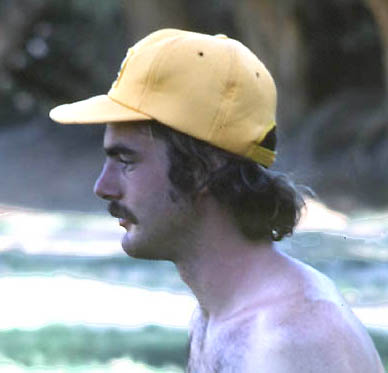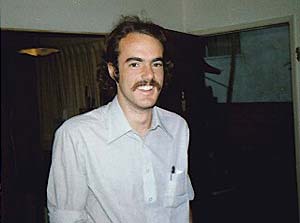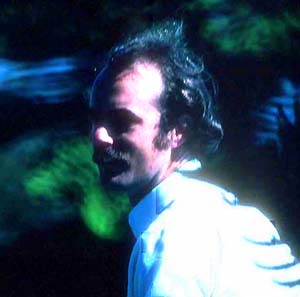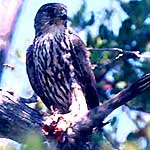 Richard
Webster is one of those hot-shot, young Turks that dazzled the birding
world in the 1970s, but perhaps none was as sharp and as brilliant in the
field. Richard built on the examples of McCaskie and Stallcup to combine
an exceptional level of book knowledge (a strength of McCaskie) with as
incredible field awareness for birds (a strength of Stallcup). Richard
was downright rapacious in his ability to find and identify rare birds;
perhaps this is how he would earn the bird name "Merlin" [although the
late '70s naming committee never revealed their reasons for any name]. Richard
Webster is one of those hot-shot, young Turks that dazzled the birding
world in the 1970s, but perhaps none was as sharp and as brilliant in the
field. Richard built on the examples of McCaskie and Stallcup to combine
an exceptional level of book knowledge (a strength of McCaskie) with as
incredible field awareness for birds (a strength of Stallcup). Richard
was downright rapacious in his ability to find and identify rare birds;
perhaps this is how he would earn the bird name "Merlin" [although the
late '70s naming committee never revealed their reasons for any name].
Richard's reputation for ability and accuracy is so great that he, alone among all California birders, had a first State record accepted by the notoriously stingy California Bird Records Committee (CBRC) based upon his single observer description (Sooty Tern flying past San Diego R. mouth on 27 Sep 1982; details in Webster et al. 1990). The CBRC has accepted very few first State records based on sight observations alone, and in all other cases either other observers were included, or there are photographs, or a single-observer record was later re-evaluated and disregarded. Richard grew up in Santa Barabara and was actively birding at a young age. He first appears in the credits of Audubon Field Notes in fall 1967. He and Louis Bevier (then in high school) pioneered such new vagrant spots in Santa Barbara County as Atascadero Creek, Old Married Student Housing gardens, Patterson Avenue fields, Gaviota, and the Storke Road tamarisks. In time, Richard would move to Ventura County and discover a welter of other new vagrant traps. He would quickly rise to have to highest Ventura County list, a position he held until long after he had moved elsewhere. His bar-graph book on the birds of Santa Barbara and Ventura counties appeared in 1980 (Webster et al. 1980). Between these bouts of California birding, Richard managed to graduate from Harvard University in the 1970s. Whatever one might say about Richard, you had to add that he was brilliant. In due course he moved to San Diego and obtained a law degree (finishing first in his class), and even practiced as an attorney for a time in the 1980s. Photo (above) at Furnace Creek in late May 1978 © Brad Schram |
|

Richard served a term on the California Bird Records Committee (1982-1984) but it is my impression that he didn't much enjoy reviewing the reports from others. Richard would much rather go birding. Richard was a member of the record-setting Big Day team on 29 Apr 1978 [with J.L. Dunn, K.L. Garrett, and J.V. Remsen]; their 231 species remains the California record for a non-airplane Big Day. Photo (right) at the Big Day celebration party in Westwood,
L.A., 30 Apr 1978 © Barry Clark
|
|
 Although
Richard's abilities as a field birder are unsurpassed, perhaps even more
impressive is his extensive knowledge of the literature. An inveterate
reader and book collector, no where is that knowledge on better display
than his classic paper on creating a birder's library (Webster 1993). By
the late 1970s, Richard was traveling well beyond California in his search
for birds, visiting tropical habitats around the globe, and gaining a particular
affinity for South America. A recent blurb from the Field Guides' web site
states: "He claims that his heart is in the American tropics, oscillating
rapidly between the Andes and Amazonia, but his increasingly frequent and
enthusiastic journeys to other continents betray his love for birds and
birding everywhere." Indeed, after our period of review (1965-1989) had
closed, Richard gave up his legal career and San Diego home to become a
tour leader for the Field Guides bird tour business. He and Rose Ann Rowlett,
a famous Texas birder who was a founder of Field Guides, recently moved
from San Diego to Portal, Arizona. It is said that he is working on a manuscript
about the birds of southern California. Although
Richard's abilities as a field birder are unsurpassed, perhaps even more
impressive is his extensive knowledge of the literature. An inveterate
reader and book collector, no where is that knowledge on better display
than his classic paper on creating a birder's library (Webster 1993). By
the late 1970s, Richard was traveling well beyond California in his search
for birds, visiting tropical habitats around the globe, and gaining a particular
affinity for South America. A recent blurb from the Field Guides' web site
states: "He claims that his heart is in the American tropics, oscillating
rapidly between the Andes and Amazonia, but his increasingly frequent and
enthusiastic journeys to other continents betray his love for birds and
birding everywhere." Indeed, after our period of review (1965-1989) had
closed, Richard gave up his legal career and San Diego home to become a
tour leader for the Field Guides bird tour business. He and Rose Ann Rowlett,
a famous Texas birder who was a founder of Field Guides, recently moved
from San Diego to Portal, Arizona. It is said that he is working on a manuscript
about the birds of southern California.
Photo (right) at Pt. Loma, SD, 6 Oct 1981 © D. Roberson |
|

Official Bird Name: Merlin
Selected publications 1980-1989:
|